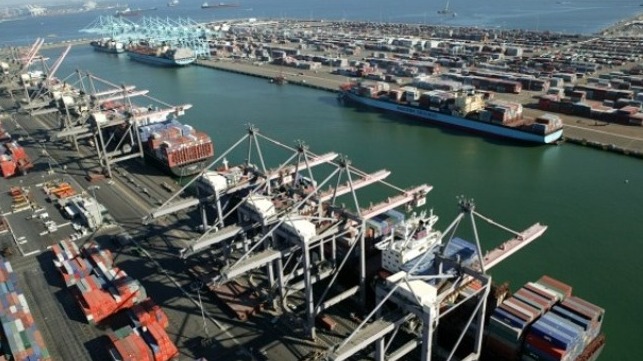Import Surge Drives Record Cargo Volume at Port of Los Angeles

After experiencing significant volume declines earlier in 2020, the Port of Los Angeles is reporting an ongoing rebound in traffic. With COVID-19 related restrictions being relaxed around the US, industry has returned to work and consumer activity has resumed contributing to the strong increases in shipping volumes. While few believe that they can make up for lost volumes from earlier in the year, they believe barring an unforeseen problem that shipping activity has returned to more normalized levels.
Typical of the increases in activity, yesterday, October 14 the Port of Los Angeles reported it had a total of 16 ships on terminal. That included 14 containerships, one bulk carrier, and a general cargo ship. Also, there were 11 ships at anchor, including four containerships, four tankers, two bulkers, and one laid up cruise ship.
The strong number of vessels arriving at the port helped Los Angeles to achieve record volumes for September and contributed to the busiest quarter in the port’s history. The results followed a strong August giving the port the first two months of year-over-year growth it experienced in 2020. Los Angeles reported a 30 percent increase in run rates for containers passing through the port versus the lows experienced in the spring of 2020.
During September, Los Angeles saw a 13 percent increase in the number of containers passing through the port to 883,625 TEUs. That brought the total for the quarter to more than 2.7 million TEUs. The year-to-date total, however remains down nearly nine percent.
September also marked the first month that Los Angeles saw no cancellations or blank voyages. The port handled a total of 97 ships which included 11 unscheduled voyages added by the carriers responding to the increased demand from shippers. So far in 2020, Los Angeles has seen a total of 31 unscheduled arrivals added by the carriers to their schedules, but that is still less than half the 66 blank voyages the port recorded this year.
The port attributed the strong gains to the replenishment of warehouse and distribution center inventories along with retailers’ efforts to prepare for the upcoming holiday retail season. They noted that consumers are buying again and that encouraged retailers to build inventories.
This demand was reflected in strong import volumes at the Port of Los Angeles. In September, import volumes increased 17 percent year-over-year to 471,795 TEUs, and for the nine months, while volume remains down five percent, the port reached 3.4 million TEUs.
The port, however highlights what it sees as a concerning trend with export volumes down 22 of the last 23 months. They believe this was in large part due to the trade tensions with China. In September the export volume was flat at approximately 103,000 TEUs while it is down 16 percent for all of 2020. Further highlighting the issue, the port pointed to the fact that the volume of empties was twice that of the exports in the month. In September, 281,434 empty TEUs were returned from Los Angeles to Asia.
"Despite unresolved questions about our nation's health, economy and export strength, imports have improved significantly after a difficult spring," said Port of Los Angeles Executive Director Gene Seroka. He however said that he believes the US needs a cohesive export plan, national infrastructure plan, and digitization strategy for ports across the country in order to address the longer-term issues that challenge the economy and the ports.
Another challenge for the port and terminal operators is the increases in the size of vessels. The port said they are averaging more than 10,000 TEUs handled with each containership in the port. In September, the MSC Oliver discharged and loaded more than 30,200 TEUs, the second highest all-time number of TEUs handled in a single ship visit at the Port of Los Angeles.
Seroka also said that the strong volumes the Port of Los Angeles is experiencing have contributed to supply chain complexities. “Surging imports have caused dwell times to increase, with longer turnaround times for trucks and more cargo on our tarmacs,” he admitted. The port has increased its use of forecasting tools helping businesses across the port plan and manage the volumes.
Using those forecasting tools, Seroka said he expects the strong trends experienced in the last two months to continue going forward. He forecast a better than 20 percent increase in TEUs passing through the port in October despite the holiday week in China. He expects a volume of 950,000 TEUs in October and while November will slow month to month he still expects a nearly 10 percent increase in TEUs over last year.
Despite the recent increases in traffic, the weaknesses earlier in the year are contributing to a down year for volumes in the Port of Los Angeles. They forecast that the port would end the calendar year 8.9 million TEUs, which represents more than a four percent decline in volumes for the year.
